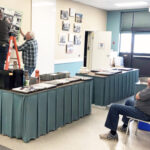
The Weathermen on Old Glory

Old Glory Mountain is the highest peak in the Rossland range of the Monashees. It has an elevation of 2377 m. or 7798 ft. and is located at 49◦ 9’ North latitude and 117◦ 55’ West in longitude approximately 12 miles NW of Rossland. The weather station was the highest manned station in North America and quite possibly in the world.
The weather station was built over the summers of 1942 and 1943 by a Doukhobor crew from Castlegar. All materials were hauled by pack horses including the cement mixed on site for the foundations and cistern. The station was anchored at the top corners using one and a half inch steel cables attached to huge eyebolts cemented in bedrock. A lightning arrestor system included six rods one on each corner and two on the chimney attached to copper wires that led down the mountain.
It officially opened on October 1, 1944. Operated by the federal Department of Transportation to provide weather information for aircraft, particularly for Trans-Canada Airlines (the predecessor of Air Canada).
The station was manned by three meteorological technicians who would provide hourly weather information by radio 24 hours a day. Although the Department had a policy against men serving more than a year due to health concerns, several men served doubles. Approximately 44 men served at the station from 1948 to 1968, with Al Laatsch recording nine years on the mountain.
Electricity was provided by a bank of 32 volt batteries charged by two Onan gas generators. Lighting drained the batteries quickly and wasn’t bright enough to read by. The electricity was used to power the two large tube radios. A telephone line ran from tree to tree to base camp and then by pole to Rossland. The line was often out of service due to tree falls and avalanches. The space was heated by a coal furnace. During the winter the station was well insulated by a thick coat of ice.
Travel in and out of the station during winter was by ski, using seal skins when necessary, and always in pairs for safety. Many sections of the journey went through avalanche paths. No one was ever severely injured or killed but there were close calls. In Rossland, the Department rented a room at the Allan Hotel for the technicians. On the way was the Yodel Inn, a ski cabin, in Squaw Basin that was used for shelter if the weather turned.
All supplies for the year were packed in by horse during the short summer. Everything the station needed including coal, gasoline, food, and hydrogen (for weather balloons) was hauled up by horse back. Wilf Gibbard won the contract in 1948 with his seven horses and did so until 1967. He and his wife, Ruth, and their children would stay at O’Brien’s ranch on Hannah creek during the hauling season.
Weather in summer brought inevitable lightning storms. St. Elmo’s fire would form on the lightning rods and pinwheel off the wires. The station would suffer several direct strikes during storms.
One technician was severely electrocuted during a lightning storm and suffered injuries from which he never recovered. The arrestor system as well as all the electronics were replaced after a severe lightning storm in 1955 ravaged everything metal in the station.
On January 2, 1968, as the result of an overheated furnace, the station burnt to the foundation. Bill Raithby the lone technician at the station barely escaped in his underwear. He sheltered in the unheated forestry lookout and would have frozen to death if a rescue party hadn’t arrived. They kept him warm and were able to get him out. The station was never rebuilt due to the cost and improved forecasting.















